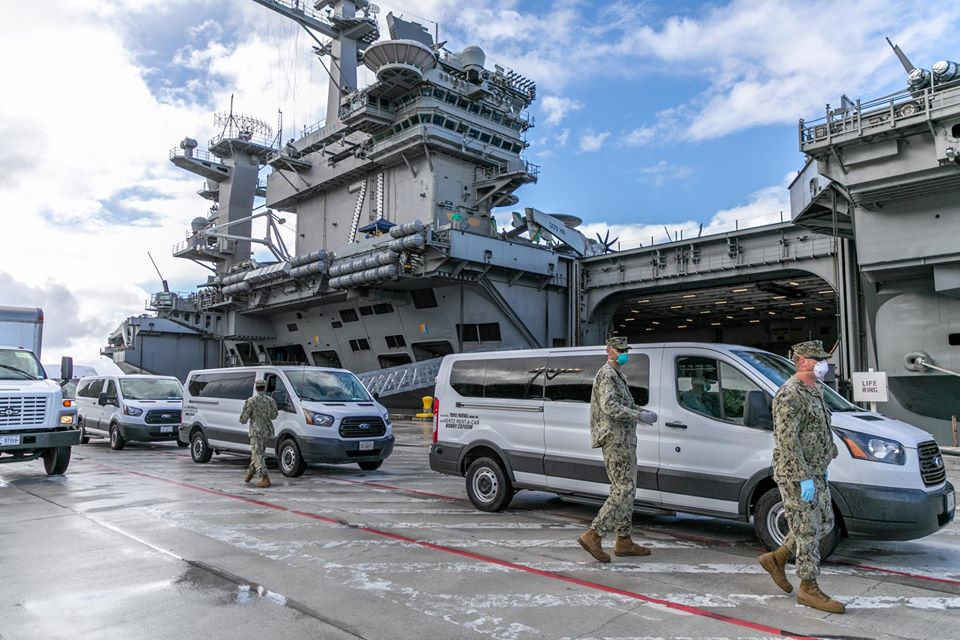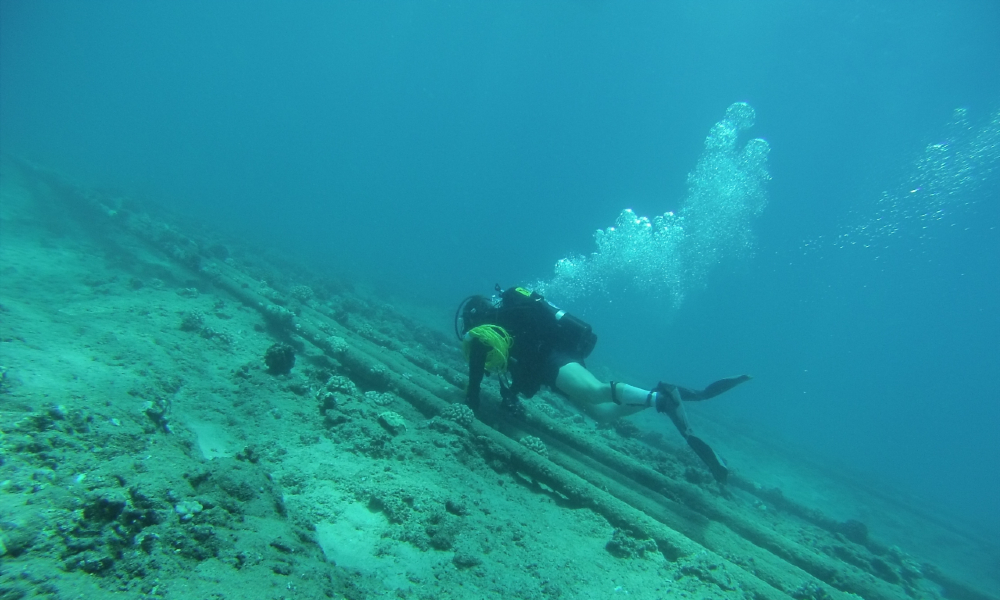Water Wars: Coronavirus Spreads Risk of Conflict Around the South China Sea
As the coronavirus upends military operations across the Indo-Pacific, naval powers commit to costly signaling on Taiwan and the South China Sea.

Published by The Lawfare Institute
in Cooperation With

Washington and Beijing are using their militaries to signal that neither is letting down its guard on Taiwan and the South China Sea during the coronavirus pandemic. Soon after Taiwan’s Vice President-Elect William Lai Ching-te visited the United States in early February, People’s Republic of China (PRC) military aircraft crossed the dividing line in the Taiwan Strait into Taiwan’s airspace two days in a row. The incursions included Chinese H-6 bombers, J-11 fighter jets and KJ-500 early warning aircraft. Taiwan responded by scrambling F-16s to shadow the Chinese aircraft out of Taiwan’s airspace. On March 19, both USS Barry (DDG 52) and USS Shiloh (CG 67) launched SM-2 missiles for a live-fire exercise in the Philippine Sea. Some Chinese military analysts deemed the exercise to be an uncommon “warning to the People’s Liberation Army [PLA].”
Then, on March 25, USS McCampbell (DDG 85) conducted a Taiwan Strait transit—the third such transit by a U.S. warship in 2020. In response to McCampbell’s transit, the spokesman for China’s Ministry of National Defense called U.S. actions “a serious violation of international laws on freedom of navigation.” However, there is little legal grounding for this assertion. The narrowest portion of the Taiwan Strait is more than 70 nautical miles wide, well beyond the 12-nautical-mile territorial sea of either coastal state. The U.N. Convention on the Law of the Sea also allows for “continuous and expeditious” transit passage through international straits as well as innocent passage of warships through the territorial seas of coastal states.
The same week as McCampbell’s transit, Taiwan held large-scale military exercises to simulate repelling an “all-out Chinese aerial invasion,” according to Taiwan’s Ministry of National Defense. Taiwan’s President Tsai Ing-wen added on March 24 that the Taiwanese “armed forces remain as vigilant as ever.” Although the Chinese, U.S. and Taiwanese military actions are individually unremarkable, they collectively signal what one analyst called posturing to prove “combat readiness remain[s] unaffected by the virus.”
Beyond Taiwan, security analysts have argued that China may be seizing the “COVID-19 advantage in the South China Sea.” China has reportedly made gains in both new research facilities and resource extraction in the South China Sea since the start of the pandemic. On March 20, Chinese media reported that China opened two new research facilities on its occupied features in the Spratlys. The Chinese Academy of Sciences will operate the two facilities on Fiery Cross (Tagalog: Kagitingan; Mandarin: Yongshu) and Subi (Tagalog: Zamora; Mandarin: Zhubi) Reefs for field studies on “deep sea ecology, geology, environment, material sciences and marine energy.” The International Business Times emphasized that China’s “supposedly civilian scientific purposes” come as the rest of the world is “distracted by coronavirus.” Then, on March 26, China’s Ministry of Natural Resources announced that it extracted and produced a record amount of natural gas in a single day in the South China Sea. The production process ran from Feb. 17 to March 18, as the coronavirus began its rapid spread around the world.
Around the South China Sea, rival Southeast Asian claimants Malaysia and the Philippines are preoccupied with enforcing mandatory quarantine measures. Philippine President Rodrigo Duterte previously self-quarantined as a precaution, and the Philippine armed forces chief of staff recently recovered from COVID-19, the respiratory disease caused by the novel coronavirus. Vietnam and Indonesia are also enforcing measures to limit the spread of the virus.
Yet Chinese naval movements in the South China Sea appear lackluster for the time being. Some reporting speculates that a decelerating Chinese economy and a military hampered by COVID-19 could force China to scale back its maritime ambitions in the South China Sea.
Despite these setbacks, Beijing is still trying to project an image of military strength. Chinese media reported that PLA-Navy surface vessels, submarines and fighter jets conducted readiness drills “in the South China Sea in late March.” On March 24, Chinese Communist Party (CCP) mouthpiece the Global Times stated that the Chinese aircraft carrier CNS Liaoning (CV 16) was hosting fighter “jet drills amid [the] epidemic.” The Global Times added that “[t]raining for war preparedness will not be stopped even in the middle of the COVID-19 epidemic.”
However, there is reason to doubt Beijing’s account of its readiness. The Global Times report included a photo from April 2018 and said the drills took place in “early spring in the Bohai Strait,” which several outlets misreported and misconstrued as in the South China Sea. The Bohai Strait is next to the carrier’s homeport of Qingdao in northeastern China—nearly 1,500 nautical miles from the South China Sea. The March 24 Global Times article also reported “zero COVID-19 cases on February 17” (emphasis added) for the new and South China Sea-based aircraft carrier the CNS Shandong (CV 17). The PLA has claimed that not a single person in its 2-million-strong military has contracted COVID-19, which is about as unbelievable as China’s underreported civilian COVID-19 tallies. Thus, the jury is still out on the true impact of COVID-19 on China’s two carriers and the PLA-Navy.
In contrast, COVID-19 has significantly and publicly impacted at least one of the U.S. Navy’s aircraft carriers in the Western Pacific. On March 31, the San Francisco Chronicle published a letter from Brett Crozier, the captain of USS Theodore Roosevelt (CVN 71), to military leadership pleading for greater assistance to control the COVID-19 outbreak among the ship’s crew of more than 4,800 sailors. He compared his situation to the COVID-19 outbreak on the Diamond Princess cruise ship and wrote, “We are not at war. Sailors do not need to die. If we do not act now, we are failing to properly take care of our most trusted asset—our Sailors.” The Theodore Roosevelt Carrier Strike Group had been conducting joint operations in the Indo-Pacific prior to the outbreak.
On April 1, then-Acting Secretary of the Navy Thomas Modly said, “The fact that [Captain Crozier] wrote the letter to his chain of command to express his concerns would absolutely not result in any kind of retaliation." But Modly fired the captain the following day for “panicking” under pressure and to preempt President Trump from having to “intervene because the Navy couldn’t be decisive.” Modly then stated that Crozier was “too naive or too stupid” to be in command if he had believed his letter would not leak, in a speech to the ship’s crew on April 6 that quickly leaked to the media. It remains unclear who leaked Crozier’s letter. Trump said he supported the firing of Crozier, declaring that “I guess the captain stopped in Vietnam and people got off in Vietnam. Perhaps you don’t do that in the middle of a pandemic or something that looked like it was going to be.” Modly subsequently resigned on April 7 over his comments to the Theodore Roosevelt crew and bungled handling of the outbreak response.
The Theodore Roosevelt had arrived in Da Nang, Vietnam, on March 5 for a five-day port visit. It was a diplomatically significant port call to signal 25 years since the restoration of U.S.-Vietnam relations. It also served a strategic purpose, emphasizing the continuing U.S. naval presence in the South China Sea at a time when military relations with the Philippines have frayed. Chief of Naval Operations Adm. Michael Gilday said that “there were only 16 positive cases in Vietnam” when the Theodore Roosevelt arrived, and Indo-Pacific Command Commander Adm. Philip Davidson made “a very risk-informed decision” to allow the port visit. At the time, Vietnam’s COVID-19 cases were all in Hanoi with none reported in Da Nang. On March 9, while the Theodore Roosevelt was wrapping up its port visit to Vietnam, Trump was still blaming the “Fake News Media” and “Democrat Party” for seeking “to inflame the CoronaVirus situation.”
Fifteen days after leaving Da Nang, three sailors on the Theodore Roosevelt tested positive for the coronavirus. Sailors are flown on and off aircraft carriers during routine operations, so it is unclear if the virus came aboard the ship from Vietnam, underway replenishments or airborne personnel transfers—a possibility Modly has cited.
As of April 7, 230 Theodore Roosevelt sailors have tested positive for the coronavirus, while none have required hospitalization. Crozier has also tested positive, but not before thousands of Theodore Roosevelt sailors cheered his name as he departed the ship for the last time. The aircraft carrier USS Ronald Reagan (CVN 76), in port in Yokosuka, Japan, has also had at least two of its sailors test positive for the coronavirus.
The firing of Capt. Crozier raises several concerns for U.S. naval operations. One concern is that commanding officers will be less likely to raise systemic issues in the future due to a culture of “shoot the messenger,” which contributed to the training and readiness deficiencies that caused the fatal USS Fitzgerald (DDG 62) and USS John S. McCain (DDG 56) collisions in the Indo-Pacific in 2017. Retired U.S. Vice Adm. William Douglas Crowder, who formerly served as Seventh Fleet commander and deputy chief of naval operations, said that his worry was the signal the stricken carrier sent to China, North Korea and Russia. “They miscalculate our ability to respond,” he told the New York Times. This concern appears well founded, with Chinese media reporting on April 3 that the “outbreak of COVID-19 has significantly lowered the US Navy's warship deployment capability in the Asia-Pacific region.”
The CCP has also professed its opposition to the firing of Crozier via the state-run Global Times. Editor Hu Xijin wrote on April 3, “[I]n our view, Crozier is more clear-minded than the officials of the Pentagon.” The CCP clearly wants the U.S. Navy to embrace the #StayAtHome mantra. Hu also compared Crozier to the Chinese “martyr” Li Wenliang—the doctor who initially raised alarms about the novel coronavirus spreading in Wuhan before being brutally silenced by the CCP and later dying from COVID-19; the CCP has since bestowed its highest title of “martyr” on Li. China has detained and disappeared several doctors, journalists and CCP members for not toeing the party line on the coronavirus. The CCP has also been orchestrating a coordinated propaganda campaign to reshape the narrative on COVID-19 and its Wuhan origins, in addition to vastly underreporting China’s numbers of COVID-19 cases and deaths.
In a time of social distancing and stay-at-home orders, navy crews worldwide are confined in tight spaces and deployed far from home. Policymakers and military commanders throughout the Indo-Pacific will have to decide if the strategic gains of naval operations outweigh the risk of COVID-19 rapidly spreading among ship crews. As the saying goes, “A ship is safe in harbor, but that’s not what ships are for.”
In Other News...
At-Sea Collisions
On March 30, a Japanese destroyer collided with a Chinese fishing boat in the East China Sea. The collision left a 3-foot by 6-inch hole in the port side of JS Shimakaze (DDG 172), which remained operational with no shipboard injuries. One of the 13 crew members on the Chinese boat complained of minor back pain after the incident. The collision occurred between Shanghai and Japan’s Yakushima Island—well north of the disputed islands (Japanese: Senkaku; Mandarin: Diaoyu) in the East China Sea.
On April 2, a China Coast Guard vessel reportedly rammed and sank a Vietnamese fishing vessel near the Paracels (Vietnamese: Hoàng Sa; Mandarin: Xisha) in the South China Sea. China detained and later released the eight Vietnamese fishermen from the sunk vessel. Both Vietnam and China assert sovereignty claims over the Paracels. During the incident, the China Coast Guard allegedly captured and towed at least two other Vietnamese fishing boats to Chinese-occupied Woody Island (Vietnamese: Phú Lâm; Mandarin: Yongxing). The Vietnamese government lodged an official protest with the Chinese government following the incident, but the China Coast Guard responded that the Vietnamese boats were illegally fishing in Chinese waters. It is the second time in less than a year that a Chinese vessel has sunk a Vietnamese fishing boat near the Paracels. The U.S. State Department said it was “seriously concerned” by the incident, calling on China to support “international efforts to combat the global pandemic, and to stop exploiting the distraction or vulnerability of other states to expand its unlawful claims in the South China Sea.” The China Coast Guard is also ramping up its protection of Chinese trawlers illegally fishing in Indonesia’s Exclusive Economic Zone, according to the New York Times.
U.S. Naval News
Four years since its commissioning, the USS Zumwalt (DDG 1000) is receiving its combat system to bring it one step closer to becoming the U.S. Navy’s first fully operational stealth destroyer. Cost overruns and ship modifications have troubled the Navy’s DDG-1000 program over the past few years. Originally intended to have a state-of-the-art rail gun for naval gunfire support, Zumwalt is now designated a ship killer with Maritime Strike Tomahawk and SM-6 missiles integrated into its combat system. Procurement and deployment of anti-ship missiles are a top priority for Navy leadership in order to counter and deter the growing fleet of Chinese PLA-Navy warships.
Analysis
Professor James Kraska of the U.S. Naval War College writes in War on the Rocks that the Chinese government may be legally responsible for trillions of dollars in damage for the COVID-19 outbreak. Kraska cites the Chinese state media’s suppression of coronavirus information, Wuhan government’s denial of human-to-human transmission, and China’s withholding of data and access from the World Health Organization as amounting to the “breach of a legal duty that China owed to other states under international law, and for which injured states—now numbering some 150 nations—may seek a legal remedy.” Possible foreign-state countermeasures include dissemination of information within China on topics such as Taiwanese media opinions and reports on Chinese belligerence against regional countries in the East and South China Seas—acts that would normally constitute a violation of national sovereignty under international law.
Retired U.S. Marine Corps Col. Mark Cancian and Brandon Schwartz argue in Proceedings that the United States should issue letters of marque to privateers in order to generate a “major wartime advantage and enhance peacetime deterrence” against China. They argue that the letters of marque are legally justifiable under both Article I, Section 8, of the U.S. Constitution and customary international law. Due to a constrained U.S. defense budget and China’s large merchant fleet, letters of marque could allow the U.S. Navy to focus on the PLA-Navy while the privateers focus on China’s 4,600-plus merchant and long-distance fishing fleets. The authors propose that the privateers would serve in a capacity analogous to the U.S. privateers who targeted the British in the War of 1812 and the 20,000 private armed contractors who operated at the height of the Iraq War.





